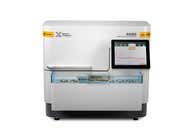Optimizing the XRD signal from surfaces and thin films
In Grazing Incidence X-Ray Diffraction (GIXRD), a beam of X-rays is directed onto a sample at a very low angle of incidence, typically less than one degree, which causes the X-rays to interact with only the top few nanometers of the material. This results in a diffraction pattern that is highly sensitive to the crystallographic properties of the surface region.
In conventional X-ray diffraction (XRD), the X-rays are incident on the sample over a wide range of angles resulting in a diffraction pattern from a depth of several microns in the sample. In GIXRD, on the other hand, the incident beam angle is fixed on a low angle which is optimised for a specific small penetration depth in order to have control over the volume of material being measured. It is specifically designed to avoid signal from below a surface or thin film.
To enable GIXRD measurements, and to obtain the best quality data, specialised incident beam and diffracted beam optics are employed.
In GIXRD measurements, the X-ray beam is directed at the sample at a very low angle of incidence, typically less than one degree. The alignment of the sample in the beam is optimized to suit the sample size and the penetration depth required. The incident beam is fixed at the optimized incident beam angle throughout the measurement.
The diffraction pattern is collected using appropriate diffracted beam optics and the most suitable detector, and analyzed using software such as Highscore to determine the crystal structure or phase composition of the surface layer. By collecting data at a variety of incident beam angles, researchers can obtain information about the phase, thickness, density, and crystallographic orientation of the surface layers.
GIXRD goes hand in hand with other powder diffraction* methods and is used primarily for phase identification and quantification of all types of polycrystalline material. It can also support residual stress measurements in thin films and surfaces.
GIXRD is suitable for any polycrystalline material where emphasis is placed on the surface layers. It is also useful for thin films when scattering from the substrate can potentially hide or dominate the relatively weak scattering from a thin layer.
(* ‘Powder diffraction’ is a term used to describe a class of XRD measurements used for polycrystalline materials that can be in powdered or solid form.)
Highscore is a powerful tool for analyzing GIXRD data, allowing researchers to quickly and accurately identify phases and quantify multiphase composition. The software can also be used for film thickness determination, multilayer simulation and the measurement of crystallite size.
For residual stress analysis the software package Stress Plus provides analysis of thin film stress.
One of the biggest advantages of GIXRD is that it is a non-destructive technique, meaning that it can be used to study samples without altering or damaging them. This is particularly important for coatings, where the integrity of the thin film must be maintained.
GIXRD is the best way to maximise signal from polycrystalline thin films or surface layers that would otherwise be dominated by the underlying substrate. It provides a cleaner diffraction pattern that is easier to analyze.
GIXRD is a quantitative technique, meaning that it can provide calibration-free measurement of the phase composition in multiphase polycrystalline materials.
Malvern Panalytical is a leading manufacturer of analytical instruments for materials science and research, including the Aeris, Empyrean and X’Pert3 MRD systems for XRD. These solutions are specifically designed to enable GIXRD measurements and, together with analysis, using Stress Plus and Highscore Software, offer a number of advanced features and capabilities for polycrystalline thin films.

The future is compact
The Aeris compact XRD is a high-performance X-ray diffractometer ideal for studying crystallographic properties of thin films and surfaces using GIXRD. It features a range of advanced capabilities, including high-resolution detectors, motorized sample stage, and range of measurement modes for maximum flexibility and precision.
Our Highscore Software is a powerful data analysis tool designed to work seamlessly with the Aeris Research Edition, providing a comprehensive solution for GIXRD measurements and analysis. It includes a range of advanced data processing and visualization tools, as well as powerful algorithms for identifying crystal structures and performing quantitative analysis.
Together, the Aeris and Highscore Software combine to provide a powerful and versatile solution that enable GIXRD measurements and analysis alongside traditional XRD, offering researchers the ability to study the crystallographic properties of a wide range of materials with unmatched precision and accuracy. Whether studying thin films, surfaces, or bulk materials, these tools are an essential part of any materials science laboratory.

Empyrean rangeMultipurpose X-ray diffractometers for your analytical needs |

AerisThe future is compact |

X'Pert³The improved X’Pert platform |
|
|---|---|---|---|